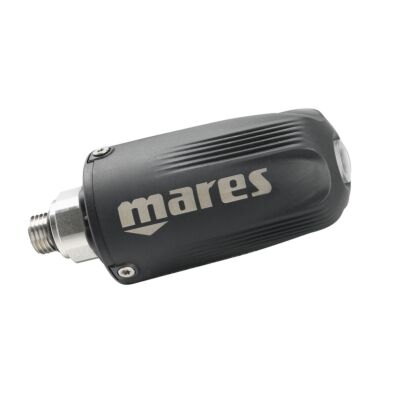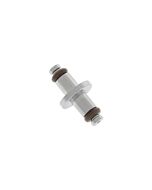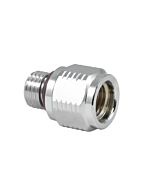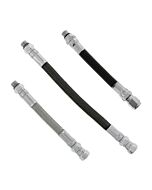Mares LED Tank Module V2.0 Transmitter
- Wireless transmission of tank pressure to your Mares Sirius dive computer
- Includes a color LED for quick tank checking on the surface
- Maximum operating depth {492 fsw | 150 msw}
- Includes LS 14250 battery (aka size 1/2 AA), battery life of 150 to 200 dives
- V2.0 of transmitter compatible only with Mares Sirius dive computer
Mares LED Tank Module V2.0 Transmitter
The LED Tank Module 2.0 is a tank pressure transmitter designed to seamlessly relay tank pressure data to the Mares Sirius computer. Once it has been associated with a dive computer, they remain permanently paired. The transmitter screws in to a standard 7/16-inch high-pressure (HP) port of the first stage regulator mounted on the tank to be monitored. The transmitter provides a secure radio connection to the dive computer and has a { 5 foot | 1.5 meter} range . The Mares Sirius can be paired with up to five (5) transmitters simultaneously in order to use several scuba tanks underwater.
The module has a color LED, and depending on the light color shown, in-water it allows your buddy to observe how much gas is in the tank. Upon pressurizing the tank module, if a pressure of {2600 psi | 180 bar} (full tank) or more is sensed, the LED will blink 10 times in GREEN color in 4-second intervals. For battery preservation, the LED turns off after the surface check and stays off until a pressure of {1450 psi | 100 bar} (half tank) is reached. At that point it blinks in YELLOW color once every 4 seconds until the tank pressure drops below {725 psi | 50 bar} (low tank) and then the LED blinks in RED color once every second.
The transmitter is Nitrox Ready and has a user replaceable, non-rechargeable size LS 14250 battery. The high pressure o-ring located at the base of the transmitter is a standard size AS568-012 and under normal circumstances the o-ring does not require routine replacement. The dive computer will display a low battery warning that indicates when the transmitter battery needs to be replaced. Like the Sirius dive computer, the V2 transmitter has a {492 fsw | 150 msw} maximum depth. Although the official Mares specifications reference the usual EN250 requirements for accuracy of mechanical pressure gauges, you can expect the ±5% full scale accuracy typical of digital gauges. For technical diving, Dive Gear Express recommends following the best practice of also including a standard analog SPG on the regulator as a backup.
In rare cases, the body of some first stage regulator designs will have hose ports oriented such there is not room to accept a wireless tank pressure transmitter without interfering with hose routing. The solution is to use a standoff adapter, or some divers prefer to use a short 6-inch HP hose pigtail (do not forget the required Air Spool) in place of the standoff.
| Brand | Mares Extended Range |
|---|---|
| SKU | XR-414322 |
| Weight | 0.450000 |
Customer Reviews
About Gas Time Remaining (GTR) Calculations
Some dive computers have the ability to monitor a sensor that allows them to provide a digital display of the gas pressure in the dive cylinder. This feature is often referred to as 'air integration' (AI) but since nearly all modern dive computers are capable of handing a variety of breathing gases the term air is a misnomer. A few of the AI computers go a step further and use the tank pressure to calculate an estimate of the breathing gas time remaining (GTR). There are a variety of different methods and formulas for GTR calculations but they all share limitations such that, for specific divers and specific dives, the GTR displayed by your computer can be wildly inaccurate.
Just to be clear, the accuracy of the GTR is not a limitation of the computer or the transmitter but because there are simply too many unknowns to make the GTR anything other than a gross approximation. Beyond the obvious factors such as environment, depth variations in a multi-level dive profile, ascent rates, and stop times; the divers gas consumption rate will vary greatly depending on changes in equipment configuration and exertion. For this reason, GTR estimates are meaningless on most technical dives and even some deeper sport dives, particularly if hunting.
Another factor that can affect the GTR depends on the algorithm used for making the estimate. Some methods require the diver to know and enter an RMV consumption rate along with the volume of gas available (i.e. 'tank size'). Other methods use an observed SAC rate to develop a prediction based on consumption history and may optionally require the cylinder rated service pressure be entered. Computers that calculate GTR based on observed SAC rate history are particularly problematic when the diver uses different capacity cylinders on different dives.
While the GTR can be useful in warning inexperienced sport divers when gas consumption is abnormally high, Dive Gear Express does not recommend relying upon dive computer GTR estimates to control or extend the dive time. Never allow the computer GTR estimate to become part of your dive plan, always closely monitor your actual tank pressure.






